Standard [CURRENT]
ASTM E 2683:2025
Standard Test Method for Measuring Heat Flux Using Flush-Mounted Insert Temperature-Gradient Gages
- Publication date
- 2025
- Original language
- English
- Pages
- 9
- Publication date
- 2025
- Original language
- English
- Pages
- 9
- DOI
- https://dx.doi.org/10.1520/E2683-25
Product information on this site:
Quick delivery via download or delivery service
Buy securely with a credit card or pay upon receipt of invoice
All transactions are encrypted
Short description
1.1 This test method describes the measurement of the net heat flux normal to a surface using gages inserted flush with the surface. The geometry is the same as heat-flux gages covered by Test Method E511 , but the measurement principle is different. The gages covered by this standard all use a measurement of the temperature gradient normal to the surface to determine the heat that is exchanged to or from the surface. Although in a majority of cases the net heat flux is to the surface, the gages operate by the same principles for heat transfer in either direction. 1.2 This general test method is quite broad in its field of application, size and construction. Two different gage types that are commercially available are described in detail in later sections as examples. A summary of common heat-flux gages is given by Diller ( 1 ). 2 Applications include both radiation and convection heat transfer. The gages used for aerospace applications are generally small (0.155 to 1.27 cm diameter), have a fast time response (10 μs to 1 s), and are used to measure heat flux levels in the range 0.1 to 10000 kW/m2. Industrial applications are sometimes satisfied with physically larger gages. 1.3 The values stated in SI units are to be regarded as the standard. The values stated in parentheses are provided for information only. 1.4 This standard does not purport to address all of the safety concerns, if any, associated with its use. It is the responsibility of the user of this standard to establish appropriate safety, health, and environmental practices and determine the applicability of regulatory limitations prior to use. 1.5 This international standard was developed in accordance with internationally recognized principles on standardization established in the Decision on Principles for the Development of International Standards, Guides and Recommendations issued by the World Trade Organization Technical Barriers to Trade (TBT) Committee.
ICS
17.200.10
DOI
https://dx.doi.org/10.1520/E2683-25
Also available in
Loading recommended items...
Loading recommended items...
Loading recommended items...

